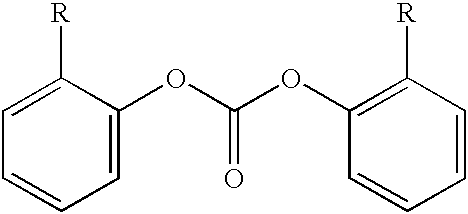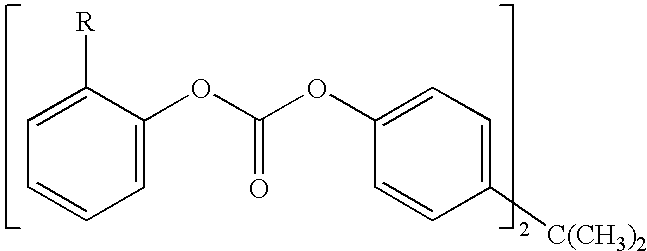Method for end-capping polycarbonate resins and composition for use in same
- Summary
- Abstract
- Description
- Claims
- Application Information
AI Technical Summary
Benefits of technology
Problems solved by technology
Method used
Image
Examples
example 2
A batch reactor tube was charged with 25 g of the pre-formed polycarbonate A, 0.1160 g (ratio end-capper to free OH=0.55) diphenyl carbonate and 0.1790 g (ratio end-capper to free OH=0.55) bis-(methyl salicyl) carbonate under nitrogen. The mixture was heated to a temperature of 300.degree. C. and stirred for 20 minutes. After the melt mixing stage, vacuum was applied to the system to a pressure of 0.5 mbar, and the reaction continued for 20 minutes. After the reaction, the polymer was sampled from the reaction tube. As summarized in Table 2, the end-cap ratio of the sample polycarbonate A was increased from 84.6% to 93.1%.
example 3
A batch reactor tube was charged with 50 g of the pre-formed polycarbonate A, 0.3481 g (ratio end-capper to free OH=0.825) diphenyl carbonate and 0.1790 g (ratio end-capper to free OH=0.275) bis-(methyl salicyl) carbonate under nitrogen. The mixture was heated to a temperature of 300.degree. C. and stirred for 20 minutes. After the melt mixing stage, vacuum was applied to the system to a pressure of 0.5 mbar, and the reaction continued for 20 minutes. After the reaction, the polymer was sampled from the reaction tube. As summarized in Table 2, the end-cap ratio of the sample polycarbonate was increased from 84.6% to 89.0%.
example 4
A batch reactor tube was charged with 50 g of the polycarbonate A, 0.1160 g (ratio end-capper to free OH=0.275) diphenyl carbonate and 0.1790 g (ratio end-capper to free OH=0.275) bis-(methyl salicyl) carbonate and 0.2950 g (ratio end-capper to free OH=0.55) methyl salicyl phenyl carbonate under nitrogen. The mixture was heated to a temperature of 300.degree. C. and stirred for 20 minutes. After the melt mixing stage, vacuum was applied to the system to a pressure of 0.5 mbar, and the reaction continued for 20 minutes. After the reaction, the polymer was sampled from the reaction tube. As summarized in Table 2, the end-cap ratio of the sample polycarbonate was increased from 84.6% to 92.7%.
PUM
| Property | Measurement | Unit |
|---|---|---|
| Fraction | aaaaa | aaaaa |
| Fraction | aaaaa | aaaaa |
| Fraction | aaaaa | aaaaa |
Abstract
Description
Claims
Application Information
 Login to View More
Login to View More - R&D
- Intellectual Property
- Life Sciences
- Materials
- Tech Scout
- Unparalleled Data Quality
- Higher Quality Content
- 60% Fewer Hallucinations
Browse by: Latest US Patents, China's latest patents, Technical Efficacy Thesaurus, Application Domain, Technology Topic, Popular Technical Reports.
© 2025 PatSnap. All rights reserved.Legal|Privacy policy|Modern Slavery Act Transparency Statement|Sitemap|About US| Contact US: help@patsnap.com



